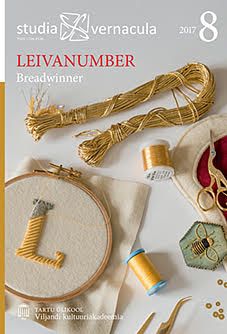Linase lapsesärgi taasloomine: uurimiskäik ja tööprotsess / Recreating children’s linen shirt: the course of research and the process of work
DOI:
https://doi.org/10.12697/sv.2017.8.174-195Abstract
Shirts form a part of Estonian folk costume. Shirts have been mainly made of linen in Estonian areas. About a century ago, the custom of wearing homemade traditional clothing disappeared, as a result of industrial development. Nowadays, there is no practical need to make traditional linen shirts for children. This article focuses on the process of making linen shirts in a situation in which several crucial steps in their production, such as flax growing and processing, and the creation of homespun linen fabrics, have ceased to exist. I adopted a practical work process as my research method, since this allowed me to gain firsthand experience of the problems encountered when sewing shirts. In parallel to this process of practical work, I collected information for analysis from historical sources and literature (archival material, museum pieces, memories). Craft professionals aided me in the selection of the best techniques.
During the work process, I sought answers to the following questions: How does the aim of creating a shirt affect the choices one makes during the work process? What are the possible technological methods one can use to achieve this? How does the use of different materials and techniques affect the visual similarity between the recreated artefact and the original? Do these techniques make the item more comfortable to wear or less so?
Taking the example of a shirt belonging to the collection of historical folk costume preserved in the Estonian National Museum (a woman’s shirt (ERM 18238) originating from Tori Parish), I created two children’s shirts. The aims that were set prior to sewing those two shirts differed. The linen fabrics that were used and the approaches to cuts and to sewing techniques were different. While the shirts are similar to the original in general terms, their details reveal variation which stems from their different materials and work techniques.
Estonian folk costume shirts were usually white. Since it is very difficult to dye linen fabrics with natural dyeing agents because of the properties of flax fibre, bleaching in sun was typically used when processing linen fabrics. However, the process of bleaching resulted in something we nowadays perceive as somewhat grey, a colour far from the so-called yellow-tinted ‘natural white’, and further still from snowy white.
According to historical sources, it was the sewing of and cutting out of the shirt from the fabric which were the most significant stages of the whole process. The written records reveal that many various prophecies were thought to lie in the act of sewing. When examining the shirts in detail, it is possible to describe the techniques and tools that have been used to create them.
The theoretical part of the article concentrates on shirts as meaningful artefacts and does so from a semiotic perspective. The practical part gives a detailed overview of the process of sewing two shirts, by sewing one of them by hand and the other with the help of a sewing machine; one of them was made from linen fabric that had been handwoven on looms at home, while the other was made from modern enzyme-treated material.
The choice of embroidery threads and sewing techniques was determined by the materials. All work procedures had to be assessed in accordance with the thickness of threads, the relations between warp and weft, and the softness of the fabric. Cuts, and the possible need for making adjustments, also needed to be considered. For example, placing a sleeve that has a selvedge as one of its edges on to a fabric is more economical in terms of material loss than the simple narrow sleeve cut that is used nowadays, where the warp thread runs along the centre line of the sleeve. I experimented with various options when sewing the collar and front parts together. However, it became evident that the solution that was visually less robust did not allow the brooch to stay in its correct position near the throat.
To conclude, changes made during the work process must not be arbitrary ones. Technological development and changing needs have resulted in the partial adjustment or change of the materials, techniques and cuts.
Keywords: folk costume, children’s clothing, shirts, sewing, linen fabrics, technology

